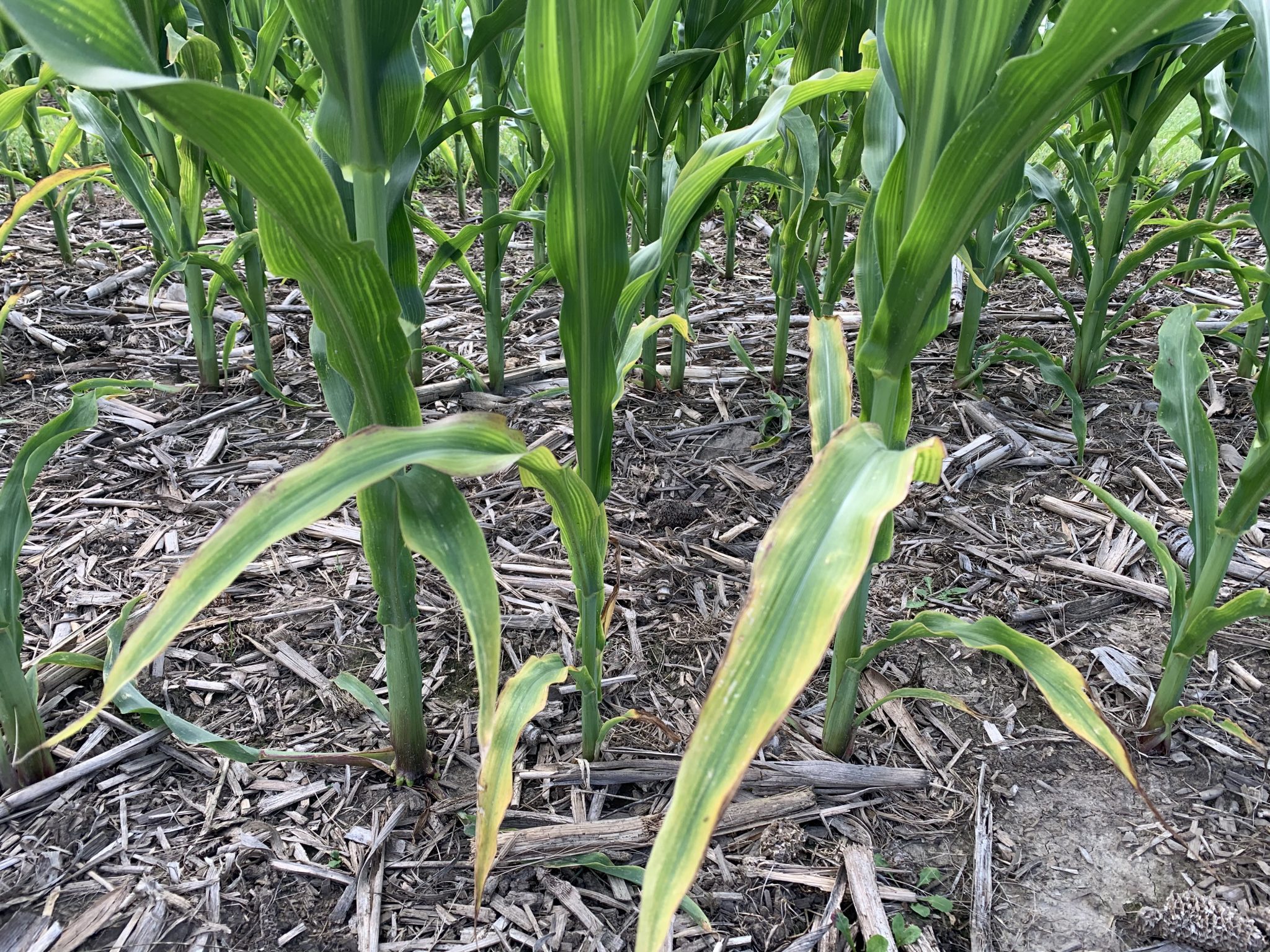This is the third article in a series of blog articles that will focus on some fundamental information on UT fertilizer recommendations for corn, with a different nutrient featured in each article. Commonly recommended nutrients for use in corn production in TN include nitrogen (N), phosphorus (P), potassium (K), sulfur (S), and zinc (Zn). Each nutrient will be discussed in terms of the relevant soil test that may be used or used in recommendation; recommended preplant, starter, sidedress, and foliar fertilizer applications; and plant/tissue analysis. Today’s blog will focus on UT potassium recommendations for optimal corn productivity under conditions in TN. Potassium is a macronutrient that plays important functions in the plant including protein and starch formation in the grain, movement of water, nutrients, and carbohydrate within the plant, stomata closure, cell wall and stalk strength. Thus, corn plants with inadequate K are susceptible to drought stress, diseases and insects, and greater risk of lodging after maturity. Additionally, K-deficient corn plants may have shorter ear length and narrower ear diameter.
Soil test for potassium
Potassium fertilizer application rate should be based on soil test. In TN, K fertilizer recommendations are based on Mehlich I extraction procedure because it correlates well with the soils in Tennessee. Detailed information on how UT recommendations were developed is addressed in UT Publication W795, University of Tennessee Fertilizer Recommendation Development. Recently, a calibration for Mehlich III was established for west TN soils and ranges of sufficiency for soil K using Mehlich III testing are described in the UT Publication, UT Fertility Recommendations for Tennessee Row Crops.
Preplant potassium fertilizer applications
Potassium is generally applied preplant in corn, either in the fall prior to planting or in the spring. Source: Potassium fertilizer sources are equal in their ability to supply K if correctly applied. The International Plant and Nutrition Institute (IPNI) developed one-page fact sheets on the various K fertilizer sources (potassium sulfate, potassium nitrate, and muriate of potash) and gave a review on their use. Placement: For soils testing medium or higher, both banding and broadcasting are effective methods of application. However, banding potash has been found to be more effective than broadcasting on soils testing low in potassium. Rate: Application rate should be based on soil test and can be modified based on crop production history.
Starter potassium fertilizer application
The additive effect of K starter fertilizer on corn yield is rarely observed in corn and starter K fertilizer application is not recommend in TN.
Sidedress potassium fertilizer application
Very little unbiased research has been done on the efficiency of sidedress K application on corn.
Foliar potassium fertilizer application
Foliar K fertilizers are not recommended for corn production in TN since unbiased field studies conducted in Tennessee show poor performance of foliar products under our growing conditions. In severe nutrient deficiency situations, it is not possible to apply K or other macronutrients (P, K, N) to foliage in amounts high enough to correct deficiency.
Plant/tissue analysis for potassium
Plant analysis helps to monitor the K status as well as diagnose deficiency in corn before deficiency symptoms become visible. Accurate interpretation of plant analysis depends on correctly sampling recommended plant parts at key growth stages. For seedling plants (< 4 inches in height), the whole plant about 1 inch above the soil surface is recommended. For corn at early growth stage (> 4 inches in height to tasseling), the most recent matured leaf (with visible collar) from the tops of 15-20 plants is recommended. For corn plants at tasseling, the earleaf (leaf adjacent to the uppermost developing ear) of 15-20 plants is recommended.
Visual deficiency symptoms
There are two key information that will accurately help you recognize deficiency symptoms, the form and location of symptoms on the affected crop will help guide the diagnosis. Location is where the symptomology occurs on the plant and this largely depends on the mobility of the nutrient within the plant. Nutrients can be classified as mobile or immobile depending on their mobility within the plant. However, for Mobile nutrients can redistributed in the plant. So for mobile nutrients, when there is insufficient supply of nutrients, nutrients in the plant is translocated to newer and growing part of the plants so deficiency symptoms tend to show on older or lower leaves. On the other hand, immobile nutrients have limited mobility within plants and deficiency symptoms occur in younger, upper leaves. Forms associated with deficiency may take several forms including chlorosis, necrosis, and abnormal growth. Chlorosis occurs when the production of chlorophyll is reduced which results in a yellow to pale green leaf color. Necrosis occurs when the plant tissue dies, indicated by the browning of the affect plant part. Abnormal growth occurs when the inadequate amounts of a nutrient in the plant restrict cell elongation and replication. This results in stunted growth, deformation, or crinkled leaves.
Potassium is a mobile nutrient as such visual deficiency symptoms occur first on older leaves and the commonly associated forms are chlorosis and abnormal growth.
Leaf: Appear first on older (lower) leaves. Yellowing and then necrosis (tissue dies) of corn leaf margin in severe cases. Yellowing starts from the tip of the leaf and progresses along the edges towards the base of the leaf.
Stalk: Narrowed stalk diameter and weaker stalk
Ear: Shorter ear length and narrower ear diameter
Figure 1: Corn plants with K deficient leaves. Potassium deficient leaves are yellowish green in color. Yellowing starts from the tip of the leaves and progresses along the edges towards the base of the lower leaves. Margins of leaf turn brown, as tissue dies (necrosis). Photo courtesy Perdue University extension Extension




